Submitted:
14 June 2023
Posted:
14 June 2023
You are already at the latest version
Abstract
Keywords:
MSC: 90B50
1. Introduction
- There is a need to map the contexts where HFLTS techniques have been applied in order to identify which SCM processes have received the most attention, which are the most studied types of SCM strategies, and which economic sectors are represented by the participating companies in these studies. The realization of a systematic review of this subject has the potential to make a contribution for researchers and practitioners by indicating trends and opportunities for future study.
- It is important to investigate issues regarding SCM decision-making processes and methods, such as for example, the types of decision-making problems in which HFLTS techniques are applied, the most often used techniques, support for GDM, and the way the application results are validated. In addition to contributing to the generation of knowledge related to the interface between SCM areas and decision making, the mapping of the state of the art of this subject will also indicate paths for the development of new computational tools to support managers in the decision-making processes in SCM.
2. HFLTSs and HFLTS Extensions
- Extended HFLTS (EHFLTS): makes it possible to create sets of non-consecutive ordered terms based on a combination of HFTLSs given by a group of DMs. As indicated in Equation (1) (Table 1), represents the set of all possible linguistic terms that express the preferences of the DMs, and indicates each of the linguistic terms chosen by them [15]. An EHFLTS can be especially useful in situations in which the DMs are divided into subgroups, and there is no consensus among the DMs which therefore leads to the need to represent evaluations in non-consecutive terms [44];
- Hesitant Intuitionistic Fuzzy Linguistic Term Set (HIFLTS): this approach deals with situations in which the DMs evaluate each alternative using a possible linguistic interval and an impossible linguistic interval. As presented in Equation (2), each HIFLTS is composed of the functions h and h’ which return finite ordered subsets of consecutive linguistic terms. h(x) and h’(x) indicate the respective possible membership degrees and non-membership degrees of element x and an HIFLTS [18];
- Interval-Valued Hesitant Fuzzy Linguistic Set (IVHFLS): is an HFLTS extension based on Interval-Valued HFSs. As shown in Equation (3), IVHFLSs incorporate the possible interval-valued membership degrees that an alternative has in relation to a linguistic term. These membership degrees are quantified by finite numbers of closed intervals which are defined in (0, 1] [36];
- Proportional HFLTS (PHFLTS): is formed by the union of the HFLTSs that correspond to the individual assessments of the DMs, which can contain consecutive or non-consecutive linguistic terms. It takes into account proportional information for each generalized linguistic term. As indicated in Equation (4), each linguistic term which makes up an PHFLTS is associated with a value, which denotes the degree of possibility that the alternative carries an assessment value provided by a group of DMs [16]. The values are computed as a function of the terms and values of ;
- Probabilistic Linguistic Term Set (PLTS): this approach adds probability distributions to an HFLTS in order to prevent the loss of any linguistic information provided by the DMs. Thus, PLTSs allow DMs to attribute possible linguistic values to an alternative or criterion at the same time that they reflect the probabilistic information of a group of attributed values. In Equation (5), is made up of the linguistic term which is associated with the probability , and is the total number of different linguistic terms in [37];
- Interval-Valued Dual Hesitant Fuzzy Linguistic Set (IVDHFLTS): considers a function for the possible membership degrees and another function for the possible degrees which do not belong to the terms selected by the DMs. In Equation (6), (x) is a set of closed interval values defined in [0, 1], which denote the possible membership degrees of ; (x) is a set of closed interval values defined in [0, 1] which represent the possible non-membership degrees [38];
- Multi-Hesitant Fuzzy Linguistic Term Set (MHFLTS): is an extension based on HFLTS and HFL elements, in which each set can contain repeated and non-consecutive linguistic terms. As shown in Equation (7), considering the sets of terms and X as the reference set, an MHFLTS in X is represented by a function which generates a finite ordered multi-subset of . indicates the possible membership degrees of element x in X [39];
- Double Hierarchy Hesitant Fuzzy Linguistic Term Set (DHHFLTS): is composed of two independent hierarchies of linguistic terms. As presented in Equation (8), considering as the first hierarchy and as the second, is defined as a DHHFLTS in which is the second term of the hierarchy when the first term is . The use of this approach makes it possible for DMs to use expressions such as “very very good”, “medium or just right”, and “between a little bad and very bad” [40];
- Hesitant Fuzzy 2-Dimension Linguistic Term Set (HF2DLTS): was proposed based on the concept of two-dimensional linguistic variables. Each set is made up of possible linguistic terms which represent a DM’s assessment of an alternative, with each term having a degree of importance denoted by a linguistic term. As represented in Equation (9), if X is a fixed set and and two sets of linguistic terms, each HF2DLTS has a function , is a set of consecutive terms in , and is a two-dimensional piece of linguistic information which expresses a DM’s assessment of the importance of . The adoption of this approach enables DMs to use linguistic expressions such as “it is certain () that () is fair”, and “it is uncertain () whether () is very good” [41];
- Probabilistic Hesitant Intuitionistic Linguistic Term Set (PHILTS): arose from the combination of HIFLTS and PLTS to reflect the probabilities of DM assessments. Thus, as shown in Equation (10), this approach takes into account membership probability data () and non-membership probability data (, with these probabilities being considered independent [27];
- Interval-Valued 2-Tuple HFLTS (IV2THFLTS): is a combination of HFLTS with interval numbers. As presented in Equation (11), each IV2THFLTS has a function (x), defined in a closed subinterval of [0, 1], which denotes the possible interval-valued membership degrees of x in This approach helps DMs avoid a loss of information and improves the accuracy of the decision-making results [17];
- Dual HFLTS (DHFLTS): is the result of a combination of HFLTSs and Dual HFSs. As shown in Equation (12), DHFLTSs include the possible membership and non-membership degrees of hs(xi) in the set S. It is useful in very risky decision-making situations, in which DMs consider not only the advantages of a decision, but also the risks of taking this decision [42];
- Hesitant Picture Fuzzy Linguistic Set (HPFLTS): is based on Picture 2-Tuple Linguistic Term Sets and arose to avoid the loss of DM information. In Equation (13), each term selected by the DM is accompanied by the crisp values of the positive membership degrees , of the undetermined membership degrees , and the negative membership degrees ( [43]. Another distinguishing characteristic of it is that this approach takes into account the refusal information concerning DMs for each assessment.
3. Methodological Procedures
4. Results and Discussion
4.1. Presentation of the selected studies
4.1.1. HFLTS-based studies
4.1.2. Studies based on HFLTS Extensions
4.2. Information about the origins of these studies
4.3. Aspects related to SCM
4.4. Aspects related to Decision Making and HFLTSs
4.5 Comparison of the results of previous studies
5. Recommendations for Future Research
5.1 Innovative applications
- Asset management: prioritization of asset management investments, strategic asset allocation, selecting the location of new installations, and layout selection;
- CRM (Customer relationship management) and marketing: marketplace selection, marketing strategy selection, market segmentation, customer satisfaction analysis, and customer relationship management software selection;
- Finance: credit risk evaluation, corporate financial performance analysis, investment appraisal, budget allocations, and the evaluation of financial plans;
- IT (Information Technology): information system selection, computer workstation selection, software quality evaluation, IT service provider selection, and disruptive industry 4.0 technology evaluation;
- Maintenance: maintenance strategy selection, maintenance service provider selection, maintenance machine selection, and the prioritization of maintenance activities;
- Occupational safety & health: accident risk evaluation, the selection of key indicators for improving the occupational safety system, the prioritization of emergency plans, individual protection equipment selection, and system reliability evaluation;
- Order management: prioritization of production orders, order delivery evaluation, and the prioritization of plans to improve order management;
- Performance evaluation: performance indicator selection, performance measurement system evaluation, and organizational performance evaluation;
- Product development: product development strategy selection, new product material selection, prototype evaluation, and product portfolio evaluation;
- Project management: project proposal selection, project risk evaluation, project performance indicator selection, project management practice maturity evaluation, and program and/or project success evaluation;
- Quality management: six sigma project selection, benchmarking, product or service requirement prioritization, selection of the certifying body for the implementation of ISO 9001 certification, and prioritization of continual improvement actions;
- Risk management: risk evaluation tool selection, organizational risk evaluation, and supply chain risk evaluation;
- Stock management: stock management strategy selection, ABC classification of stocks, warehouse location selection, and warehouse structure selection;
- Supply management: make or buy, supplier performance monitoring; supplier segmentation, and supplier development program evaluation;
- Personnel management: organizational climate evaluation, personnel selection, position evaluation, and skills and qualifications evaluation;
- Sustainability: waste treatment alternative evaluation, prioritization of sanitary landfill location selection actions, prioritization of actions designed to promote sustainability, evaluation of the barriers to the adoption of sustainable practices, and product lifecycle evaluation;
- Transportation: route selection, modes of transport evaluation, logistics service provider selection, vehicle selection, and geographic information system selection.
5.2 Technique integration
5.3 Comparison of techniques
5.4 GDM issues
5.5 Validation of new decision-making models
6. Conclusion
Author Contributions
Funding
Acknowledgments
Conflicts of Interest
References
- Lambert, D.M.; Enz, M.G. Issues in Supply Chain Management: Progress and Potential. Ind. Mark. Manag. 2017, 62, 1–16. [Google Scholar] [CrossRef]
- Rinaldi, M.; Murino, T.; Gebennini, E.; Morea, D.; Bottani, E. A Literature Review on Quantitative Models for Supply Chain Risk Management: Can They Be Applied to Pandemic Disruptions? Comput. Ind. Eng. 2022, 170, 108329. [Google Scholar] [CrossRef] [PubMed]
- Lima-Junior, F.R.; Carpinetti, L.C.R. An Adaptive Network-Based Fuzzy Inference System to Supply Chain Performance Evaluation Based on SCOR® Metrics. Comput. Ind. Eng. 2020, 139, 106191. [Google Scholar] [CrossRef]
- Borges, W.V.; Lima Junior, F.R.; Peinado, J.; Carpinetti, L.C.R. A Hesitant Fuzzy Linguistic TOPSIS Model to Support Supplier Segmentation. Rev. Adm. Contemp. 2022, 26. [Google Scholar] [CrossRef]
- Yang, M.; Lim, M.K.; Qu, Y.; Ni, D.; Xiao, Z. Supply Chain Risk Management with Machine Learning Technology: A Literature Review and Future Research Directions. Comput. Ind. Eng. 2023, 175, 108859. [Google Scholar] [CrossRef]
- Lima-Junior, F.R.; Carpinetti, L.C.R. Quantitative Models for Supply Chain Performance Evaluation: A Literature Review. Comput. Ind. Eng. 2017, 113, 333–346. [Google Scholar] [CrossRef]
- Resende, C.H.L.; Geraldes, C.A.S.; Lima Junior, F.R.; Lima, F.R. Decision Models for Supplier Selection in Industry 4.0 Era: A Systematic Literature Review. Procedia Manuf. 2021, 55, 492–499. [Google Scholar] [CrossRef]
- Finger, G.S.W.; Lima-Junior, F.R. A Hesitant Fuzzy Linguistic QFD Approach for Formulating Sustainable Supplier Development Programs. Int. J. Prod. Econ. 2022, 247, 108428. [Google Scholar] [CrossRef]
- Qin, R.; Liao, H.; Jiang, L. An Enhanced Even Swaps Method Based on Prospect Theory with Hesitant Fuzzy Linguistic Information and Its Application to the Selection of Emergency Logistics Plans under the COVID-19 Pandemic Outbreak. J. Oper. Res. Soc. 2022, 73, 1227–1239. [Google Scholar] [CrossRef]
- Wu, Z.; Xu, J.; Jiang, X.; Zhong, L. Two MAGDM Models Based on Hesitant Fuzzy Linguistic Term Sets with Possibility Distributions: VIKOR and TOPSIS. Inf. Sci. (Ny). 2019, 473, 101–120. [Google Scholar] [CrossRef]
- Wang, H.; Xu, Z.; Zeng, X.-J.J.X.-J. Hesitant Fuzzy Linguistic Term Sets for Linguistic Decision Making: Current Developments, Issues and Challenges. Inf. Fusion 2018, 43, 1–12. [Google Scholar] [CrossRef]
- Wang, H.; Xu, Z.; Zeng, X.-J.J.X.-J. Modeling Complex Linguistic Expressions in Qualitative Decision Making: An Overview. Knowledge-Based Syst. 2018, 144, 174–187. [Google Scholar] [CrossRef]
- Riahi, Y.; Saikouk, T.; Gunasekaran, A.; Badraoui, I. Artificial Intelligence Applications in Supply Chain: A Descriptive Bibliometric Analysis and Future Research Directions. Expert Syst. Appl. 2021, 173, 114702. [Google Scholar] [CrossRef]
- Rodriguez, R.M.; Martinez, L.; Herrera, F. Hesitant Fuzzy Linguistic Term Sets for Decision Making. IEEE Trans. Fuzzy Syst. 2012, 20, 109–119. [Google Scholar] [CrossRef]
- Wang, H. Extended Hesitant Fuzzy Linguistic Term Sets and Their Aggregation in Group Decision Making. Int. J. Comput. Intell. Syst. 2015, 8, 14. [Google Scholar] [CrossRef]
- Chen, Z.-S.; Chin, K.-S.; Li, Y.-L.; Yang, Y. Proportional Hesitant Fuzzy Linguistic Term Set for Multiple Criteria Group Decision Making. Inf. Sci. (Ny). 2016, 357, 61–87. [Google Scholar] [CrossRef]
- Si, G.; Liao, H.; Yu, D.; Llopis-Albert, C. Interval-Valued 2-Tuple Hesitant Fuzzy Linguistic Term Set and Its Application in Multiple Attribute Decision Making. J. Intell. Fuzzy Syst. 2018, 34, 4225–4236. [Google Scholar] [CrossRef]
- Beg, I.; Rashid, T. Hesitant Intuitionistic Fuzzy Linguistic Term Sets. Notes Intuitionistic Fuzzy Sets 2014, 20, 53–64. [Google Scholar]
- Osiro, L.; Lima-Junior, F.R.; Carpinetti, L.C.R. A Group Decision Model Based on Quality Function Deployment and Hesitant Fuzzy for Selecting Supply Chain Sustainability Metrics. J. Clean. Prod. 2018, 183, 964–978. [Google Scholar] [CrossRef]
- Lu, K.; Liao, H.; Kazimieras Zavadskas, E. An Overview of Fuzzy Techniques in Supply Chain Management: Bibliometrics, Methodologies, Applications and Future Directions. Technol. Econ. Dev. Econ. 2021, 27, 402–458. [Google Scholar] [CrossRef]
- De, A.; Singh, S.P. Analysis of Fuzzy Applications in the Agri-Supply Chain: A Literature Review. J. Clean. Prod. 2021, 283, 124577. [Google Scholar] [CrossRef]
- Liao, H.; Gou, X.; Xu, Z. A Survey of Decision Making Theory and Methodologies of Hesitant Fuzzy Linguistic Term Set. Xitong Gongcheng Lilun yu Shijian/System Eng. Theory Pract. 2017, 37, 35–48. [Google Scholar] [CrossRef]
- Morente-Molinera, J.A.; Pérez, I.J.; Ureña, M.R.; Herrera-Viedma, E. On Multi-Granular Fuzzy Linguistic Modeling in Group Decision Making Problems: A Systematic Review and Future Trends. Knowledge-Based Syst. 2015, 74, 49–60. [Google Scholar] [CrossRef]
- Yu, D.; Sheng, L.; Xu, Z. Knowledge Diffusion Trajectories in the Hesitant Fuzzy Domain in the Past Decade: A Citation-Based Analysis. Int. J. Fuzzy Syst. 2022, 24, 2382–2396. [Google Scholar] [CrossRef]
- Zadeh, L.A. Fuzzy Sets. Inf. Control 1965, 8, 338–353. [Google Scholar] [CrossRef]
- Lima Junior, F.R.; Osiro, L.; Carpinetti, L.C.R. A Comparison between Fuzzy AHP and Fuzzy TOPSIS Methods to Supplier Selection. Appl. Soft Comput. 2014, 21, 194–209. [Google Scholar] [CrossRef]
- Malik, M.G.A.; Bashir, Z.; Rashid, T.; Ali, J. Probabilistic Hesitant Intuitionistic Linguistic Term Sets in Multi-Attribute Group Decision Making. Symmetry (Basel). 2018, 10, 392. [Google Scholar] [CrossRef]
- Torra, V. Hesitant Fuzzy Sets. Int. J. Intell. Syst. 2010, 25, 529–539. [Google Scholar] [CrossRef]
- Rodríguez, R.M.; Martı́nez, L.; Herrera, F.; Martínez, L.; Herrera, F. A Group Decision Making Model Dealing with Comparative Linguistic Expressions Based on Hesitant Fuzzy Linguistic Term Sets. Inf. Sci. (Ny). 2013, 241, 28–42. [Google Scholar] [CrossRef]
- Liu, P.; Shi, L. The Generalized Hybrid Weighted Average Operator Based on Interval Neutrosophic Hesitant Set and Its Application to Multiple Attribute Decision Making. Neural Comput. Appl. 2015, 26, 457–471. [Google Scholar] [CrossRef]
- Kong, M.; Ren, F.; Park, D.-S.; Hao, F.; Pei, Z. An Induced Hesitant Linguistic Aggregation Operator and Its Application for Creating Fuzzy Ontology. KSII Trans. Internet Inf. Syst. 2018, 12, 4952–4975. [Google Scholar] [CrossRef]
- Zhang, Z.; Wu, C. Hesitant Fuzzy Linguistic Aggregation Operators and Their Applications to Multiple Attribute Group Decision Making. J. Intell. \& Fuzzy Syst. 2014, 26, 2185–2202. [Google Scholar] [CrossRef]
- Liao, H.; Xu, Z.; Zeng, X.J. Distance and Similarity Measures for Hesitant Fuzzy Linguistic Term Sets and Their Application in Multi-Criteria Decision Making. Inf. Sci. (Ny). 2014, 271, 125–142. [Google Scholar] [CrossRef]
- Liu, D.; Liu, Y.; Chen, X. The New Similarity Measure and Distance Measure of a Hesitant Fuzzy Linguistic Term Set Based on a Linguistic Scale Function. Symmetry (Basel). 2018, 10. [Google Scholar] [CrossRef]
- Ren, P.; Wang, X.; Xu, Z.; Zeng, X.-J. Hesitant Fuzzy Linguistic Iterative Method for Consistency and Consensus-Driven Group Decision Making. Comput. Ind. Eng. 2022, 173, 108673. [Google Scholar] [CrossRef]
- Wang, J.; Wu, J.; Wang, J.; Zhang, H.; Chen, X. Interval-Valued Hesitant Fuzzy Linguistic Sets and Their Applications in Multi-Criteria Decision-Making Problems. Inf. Sci. (Ny). 2014, 288, 55–72. [Google Scholar] [CrossRef]
- Pang, Q.; Wang, H.; Xu, Z. Probabilistic Linguistic Term Sets in Multi-Attribute Group Decision Making. Inf. Sci. (Ny). 2016, 369, 128–143. [Google Scholar] [CrossRef]
- Qi, X.; Liang, C.; Zhang, J. Multiple Attribute Group Decision Making Based on Generalized Power Aggregation Operators under Interval-Valued Dual Hesitant Fuzzy Linguistic Environment. Int. J. Mach. Learn. Cybern. 2016, 7, 1147–1193. [Google Scholar] [CrossRef]
- Wang, J.; Wang, J.; Zhang, H.; Chen, X. Multi-Criteria Group Decision-Making Approach Based on 2-Tuple Linguistic Aggregation Operators with Multi-Hesitant Fuzzy Linguistic Information. Int. J. Fuzzy Syst. 2016, 18, 81–97. [Google Scholar] [CrossRef]
- Gou, X.; Liao, H.; Xu, Z.; Herrera, F. Double Hierarchy Hesitant Fuzzy Linguistic Term Set and MULTIMOORA Method: A Case of Study to Evaluate the Implementation Status of Haze Controlling Measures. Inf. Fusion 2017, 38, 22–34. [Google Scholar] [CrossRef]
- Liu, X.; Ju, Y.; Qu, Q. Hesitant Fuzzy 2-Dimension Linguistic Term Set and Its Application to Multiple Attribute Group Decision Making. Int. J. Fuzzy Syst. 2018, 20, 2301–2321. [Google Scholar] [CrossRef]
- Zhang, R.; Li, Z.; Liao, H. Multiple-Attribute Decision-Making Method Based on the Correlation Coefficient between Dual Hesitant Fuzzy Linguistic Term Sets. Knowledge-Based Syst. 2018, 159, 186–192. [Google Scholar] [CrossRef]
- Yang, L.; Wu, X.H.X.-H.; Qian, J. A Novel Multicriteria Group Decision-Making Approach with Hesitant Picture Fuzzy Linguistic Information. Math. Probl. Eng. 2020, 2020, 1–19. [Google Scholar] [CrossRef]
- Ghadikolaei, A.S.; Madhoushi, M.; Divsalar, M. Extension of the VIKOR Method for Group Decision Making with Extended Hesitant Fuzzy Linguistic Information. Neural Comput. Appl. 2018, 30, 3589–3602. [Google Scholar] [CrossRef]
- Page, M.J.; McKenzie, J.E.; Bossuyt, P.M.; Boutron, I.; Hoffmann, T.C.; Mulrow, C.D.; Shamseer, L.; Tetzlaff, J.M.; Akl, E.A.; Brennan, S.E.; et al. The PRISMA 2020 Statement: An Updated Guideline for Reporting Systematic Reviews. BMJ 2021, n71. [Google Scholar] [CrossRef] [PubMed]
- Zimmer, K.; Fröhling, M.; Schultmann, F. Sustainable Supplier Management – a Review of Models Supporting Sustainable Supplier Selection, Monitoring and Development. Int. J. Prod. Res. 2016, 54, 1412–1442. [Google Scholar] [CrossRef]
- Kabak, Ö.; Ervural, B. Multiple Attribute Group Decision Making: A Generic Conceptual Framework and a Classification Scheme. Knowledge-Based Syst. 2017, 123, 13–30. [Google Scholar] [CrossRef]
- SCC Supply Chain Council; 2012.
- Liao, H.; Wen, Z.; Liu, L. INTEGRATING BWM AND ARAS UNDER HESITANT LINGUISTIC ENVIRONMENT FOR DIGITAL SUPPLY CHAIN FINANCE SUPPLIER SECTION. Technol. Econ. Dev. Econ. 2019, 25, 1188–1212. [Google Scholar] [CrossRef]
- Dolatabad, A.H.; Heidary Dahooie, J.; Antucheviciene, J.; Azari, M.; Razavi Hajiagha, S.H.; Dolatabad, A.H.; Heidary Dahooie, J.; Antucheviciene, J.; Azari, M.; Razavi Hajiagha, S.H. Supplier Selection in the Industry 4.0 Era by Using a Fuzzy Cognitive Map and Hesitant Fuzzy Linguistic VIKOR Methodology. Environ. Sci. Pollut. Res. 2023, 30, 52923–52942. [Google Scholar] [CrossRef]
- Liu, P.; Zhang, X.; Pedrycz, W. A Consensus Model for Hesitant Fuzzy Linguistic Group Decision-Making in the Framework of {Dempster}–{Shafer} Evidence Theory. Knowledge-Based Syst. 2021, 212, 106559. [Google Scholar] [CrossRef]
- Lima Junior, F.R.; Hsiao, M. A Hesitant Fuzzy Topsis Model to Supplier Performance Evaluation. DYNA 2021, 88, 126–135. [Google Scholar] [CrossRef]
- Erol, I.; Murat Ar, I.; Peker, I.; Searcy, C. Alleviating the Impact of the Barriers to Circular Economy Adoption Through Blockchain: An Investigation Using an Integrated MCDM-Based QFD With Hesitant Fuzzy Linguistic Term Sets. Comput. Ind. Eng. 2022, 165, 107962. [Google Scholar] [CrossRef]
- Tüysüz, F.; Şimşek, B. A Hesitant Fuzzy Linguistic Term Sets-Based AHP Approach for Analyzing the Performance Evaluation Factors: An Application to Cargo Sector. Complex Intell. Syst. 2017, 3, 167–175. [Google Scholar] [CrossRef]
- Pérez-Domínguez, L.; Luviano-Cruz, D.; Valles-Rosales, D.; Hernández Hernández, J.; Rodríguez Borbón, M.; Hernández, J.I.H.J.I.H.; Borbón, M.I.R.M.I.R.; Hernández Hernández, J.; Rodríguez Borbón, M. Hesitant Fuzzy Linguistic Term and TOPSIS to Assess Lean Performance. Appl. Sci. 2019, 9, 873. [Google Scholar] [CrossRef]
- Büyüközkan, G.; Güler, M. A Combined Hesitant Fuzzy MCDM Approach for Supply Chain Analytics Tool Evaluation. Appl. Soft Comput. 2021, 112, 107812. [Google Scholar] [CrossRef]
- Zheng, C.; Peng, B.; Zhao, X.; Wei, G.; Wan, A.; Yue, M. A Large Group Hesitant Fuzzy Linguistic DEMATEL Approach for Identifying Critical Success Factors in Public Health Emergencies. Aslib J. Inf. Manag. 2022; ahead-of-p. [Google Scholar] [CrossRef]
- Wu, Y.; Jia, W.; Li, L.; Song, Z.; Xu, C.; Liu, F. Risk Assessment of Electric Vehicle Supply Chain Based on Fuzzy Synthetic Evaluation. Energy 2019, 182, 397–411. [Google Scholar] [CrossRef]
- Chang, K.-H.; Wen, T.-C.; Chung, H.-Y. Soft Failure Mode and Effects Analysis Using the OWG Operator and Hesitant Fuzzy Linguistic Term Sets. J. Intell. Fuzzy Syst. 2018, 34, 2625–2639. [Google Scholar] [CrossRef]
- Wu, H.; Xu, Z. Cognitively Inspired Multi-Attribute Decision-Making Methods Under Uncertainty: A State-of-the-Art Survey. Cognit. Comput. 2022, 14, 511–530. [Google Scholar] [CrossRef]
- Yalçin, N.; Pehlivan, N.Y.N.Y. Application of the Fuzzy CODAS Method Based on Fuzzy Envelopes for Hesitant Fuzzy Linguistic Term Sets: A Case Study on a Personnel Selection Problem. Symmetry (Basel). 2019, 11, 493. [Google Scholar] [CrossRef]
- Krishankumar, R.; Ravichandran, K.S.; Shyam, V.; Sneha, S.V.; Kar, S.; Garg, H. Multi-Attribute Group Decision-Making Using Double Hierarchy Hesitant Fuzzy Linguistic Preference Information. Neural Comput. Appl. 2020, 32, 14031–14045. [Google Scholar] [CrossRef]
- Krishankumar, R.; Ravichandran, K.S.; Kar, S.; Gupta, P.; Mehlawat, M.K. Double-Hierarchy Hesitant Fuzzy Linguistic Term Set-Based Decision Framework for Multi-Attribute Group Decision-Making. Soft Comput. 2021, 25, 2665–2685. [Google Scholar] [CrossRef]
- Krishankumar, R.; Pamucar, D.; Pandey, A.; Kar, S.; Ravichandran, K.S. Double Hierarchy Hesitant Fuzzy Linguistic Information Based Framework for Personalized Ranking of Sustainable Suppliers. Environ. Sci. Pollut. Res. 2022, 29, 65371–65390. [Google Scholar] [CrossRef]
- Shen, M.; Liu, P. Risk Assessment of Logistics Enterprises Using FMEA Under Free Double Hierarchy Hesitant Fuzzy Linguistic Environments. Int. J. Inf. Technol. Decis. Mak. 2021, 20, 1221–1259. [Google Scholar] [CrossRef]
- Dai, J.; Pang, J.; Luo, Q.; Huang, Q. Failure Evaluation of Electronic Products Based on Double Hierarchy Hesitant Fuzzy Linguistic Term Set and K-Means Clustering Algorithm. Symmetry (Basel). 2022, 14, 2555. [Google Scholar] [CrossRef]
- Duan, C.-Y.; Chen, X.-Q.; Shi, H.; Liu, H.-C. A New Model for Failure Mode and Effects Analysis Based on k -Means Clustering Within Hesitant Linguistic Environment. IEEE Trans. Eng. Manag. 2022, 69, 1837–1847. [Google Scholar] [CrossRef]
- Wang, X.; Gou, X.; Xu, Z. Assessment of Traffic Congestion with ORESTE Method under Double Hierarchy Hesitant Fuzzy Linguistic Environment. Appl. Soft Comput. 2020, 86, 105864. [Google Scholar] [CrossRef]
- Li, P.; Liu, J.; Wei, C. Factor Relation Analysis for Sustainable Recycling Partner Evaluation Using Probabilistic Linguistic DEMATEL. Fuzzy Optim. Decis. Mak. 2020, 19, 471–497. [Google Scholar] [CrossRef]
- Zhang, X.; Su, T.; Xin, B. The Dominance Degree-Based Heterogeneous Linguistic Decision-Making Technique for Sustainable 3PRLP Selection. Complexity 2020, 2020. [Google Scholar] [CrossRef]
- Zhang, Z.; Liao, H.; Al-Barakati, A.; Zavadskas, E.K.E.K.; Antuchevičienė, J. Supplier Selection for Housing Development by an Integrated Method with Interval Rough Boundaries. Int. J. Strateg. Prop. Manag. 2020, 24, 269–284. [Google Scholar] [CrossRef]
- Wang, J.; Wang, J.; Tian, Z.; Zhao, D. A Multihesitant Fuzzy Linguistic Multicriteria Decision-Making Approach for Logistics Outsourcing with Incomplete Weight Information. Int. Trans. Oper. Res. 2018, 25, 831–856. [Google Scholar] [CrossRef]
- Divsalar, M.; Ahmadi, M.; Nemati, Y. A SCOR-Based Model to Evaluate LARG Supply Chain Performance Using a Hybrid MADM Method. IEEE Trans. Eng. Manag. 2020. [Google Scholar] [CrossRef]
- Qu, G.; Xue, R.; Li, T.; Qu, W.; Xu, Z. A Stochastic Multi-Attribute Method for Measuring Sustainability Performance of a Supplier Based on a Triple Bottom Line Approach in a Dual Hesitant Fuzzy Linguistic Environment. Int. J. Environ. Res. Public Health 2020, 17, 2138. [Google Scholar] [CrossRef]
- Wu, X.-H.; Yang, L.; Qian, J. Selecting Personnel with the Weighted Cross-Entropy TOPSIS of Hesitant Picture Fuzzy Linguistic Sets. J. Math. 2021, 2021, 1–26. [Google Scholar] [CrossRef]
- Karmaker, C.L.; Aziz, R. Al; Palit, T.; Bari, A.B.M.M. Analyzing Supply Chain Risk Factors in the Small and Medium Enterprises under Fuzzy Environment: Implications towards Sustainability for Emerging Economies. Sustain. Technol. Entrep. 2023, 2, 100032. [Google Scholar] [CrossRef]
- Krishankumar, R.; Ravichandran, K.S.; Liao, H.; Kar, S. An Integrated Decision Framework for Group Decision-Making with Double Hierarchy Hesitant Fuzzy Linguistic Information and Unknown Weights. Int. J. Comput. Intell. Syst. 2020, 13, 624–637. [Google Scholar] [CrossRef]
- Krishankumar, R.; Arun, K.; Kumar, A.; Rani, P.; Ravichandran, K.S.; Gandomi, A.H. Double-Hierarchy Hesitant Fuzzy Linguistic Information-Based Framework for Green Supplier Selection with Partial Weight Information. Neural Comput. Appl. 2021, 33, 14837–14859. [Google Scholar] [CrossRef]
- Zolfaghari, S.; Mousavi, S.M. A New Risk Evaluation Methodology Based on FMEA, MULTIMOORA, TPOP, and Interval-Valued Hesitant Fuzzy Linguistic Sets with an Application to Healthcare Industry. Kybernetes 2021, 50, 2521–2547. [Google Scholar] [CrossRef]
- Wu, P.; Zhou, L.; Martínez, L. An Integrated Hesitant Fuzzy Linguistic Model for Multiple Attribute Group Decision-Making for Health Management Center Selection. Comput. Ind. Eng. 2022, 171, 108404. [Google Scholar] [CrossRef]
- Ren, P.; Hao, Z.; Wang, X.; Zeng, X.-J.; Xu, Z. Decision-Making Models Based on Incomplete Hesitant Fuzzy Linguistic Preference Relation With Application to Site Selection of Hydropower Stations. IEEE Trans. Eng. Manag. 2022, 69, 904–915. [Google Scholar] [CrossRef]
- Lima, B.P.; da Silva, A.F.; Marins, F.A.S. New Hybrid AHP-QFD-PROMETHEE Decision-Making Support Method in the Hesitant Fuzzy Environment: An Application in Packaging Design Selection. J. Intell. Fuzzy Syst. 2022, 42, 2881–2897. [Google Scholar] [CrossRef]
- Kumar Singh, R.; Modgil, S. Assessment of Lean Supply Chain Practices in Indian Automotive Industry. Glob. Bus. Rev. 2023, 24, 68–105. [Google Scholar] [CrossRef]
- Dang, T.-T.; Nguyen, N.-A.-T.; Nguyen, V.-T.-T.; Dang, L.-T.-H. A Two-Stage Multi-Criteria Supplier Selection Model for Sustainable Automotive Supply Chain under Uncertainty. Axioms 2022, 11, 228. [Google Scholar] [CrossRef]
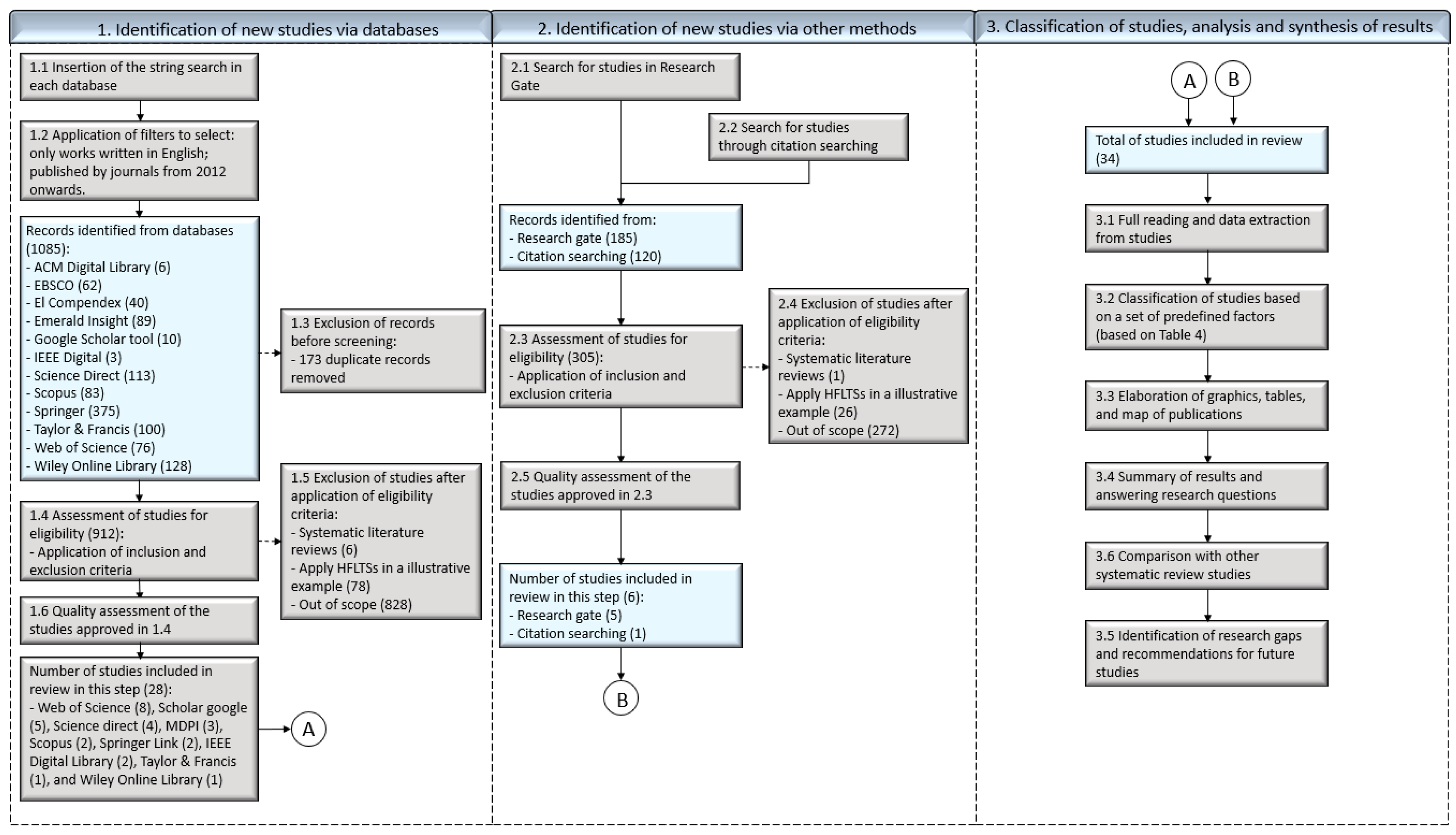
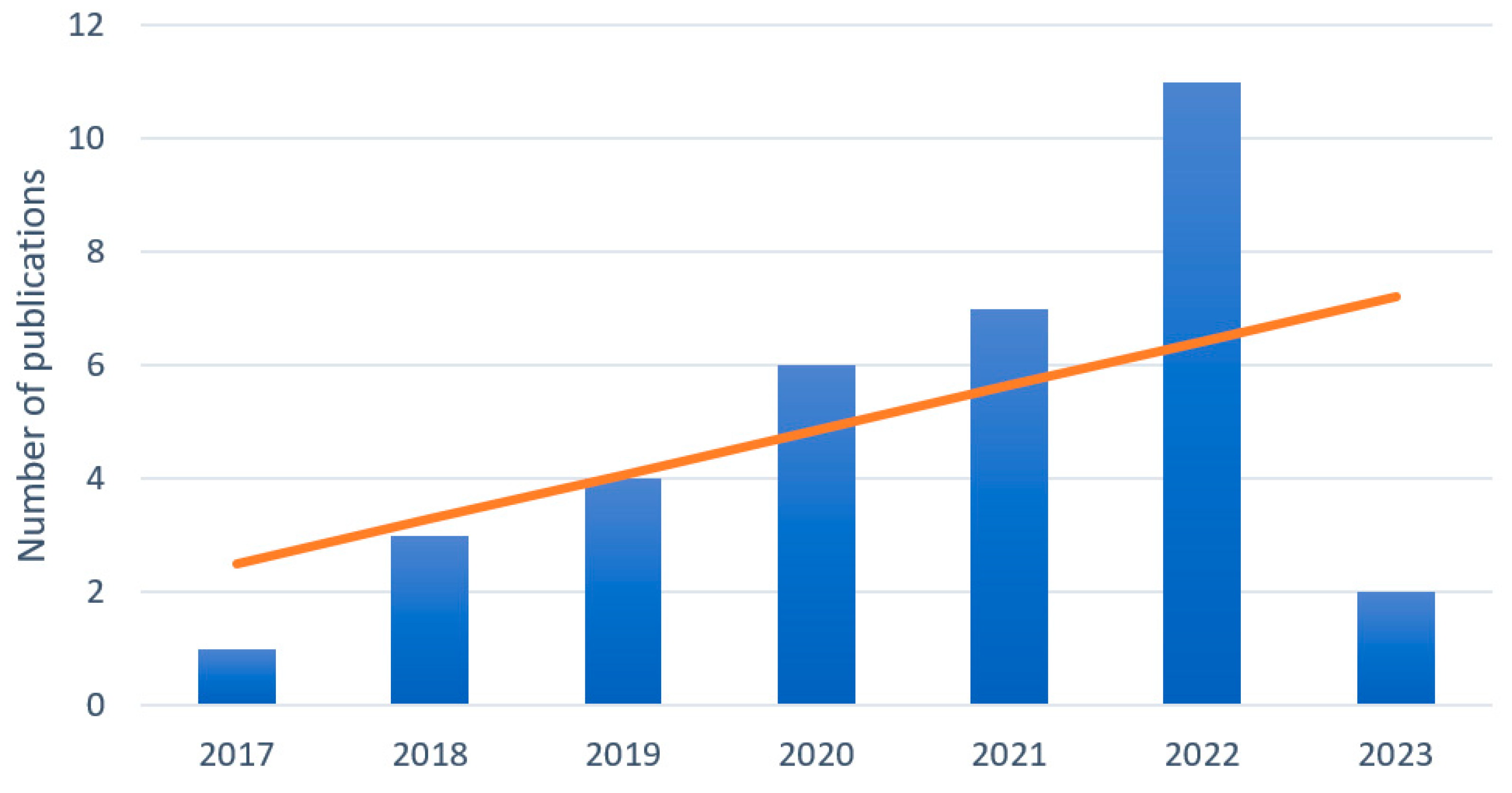
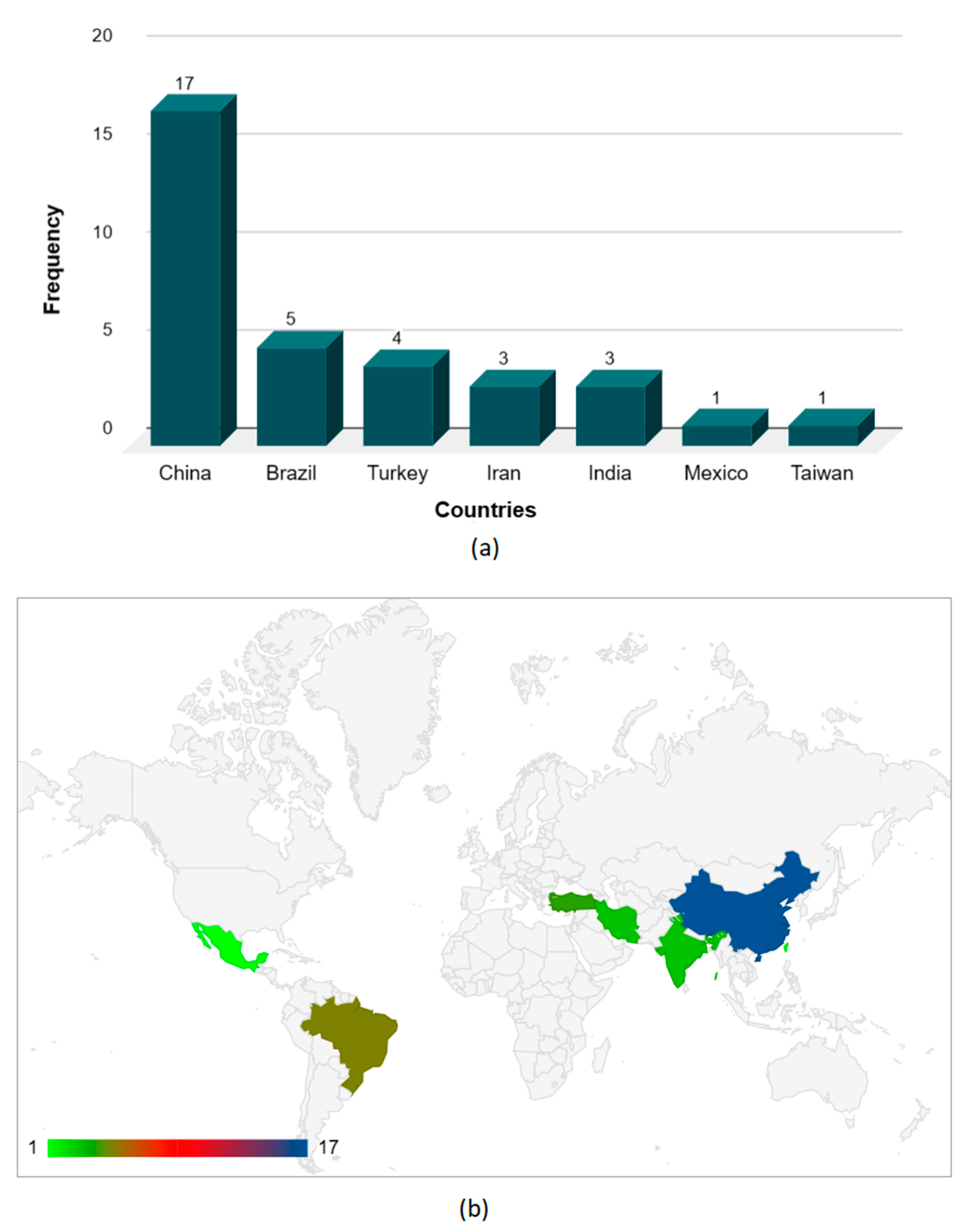
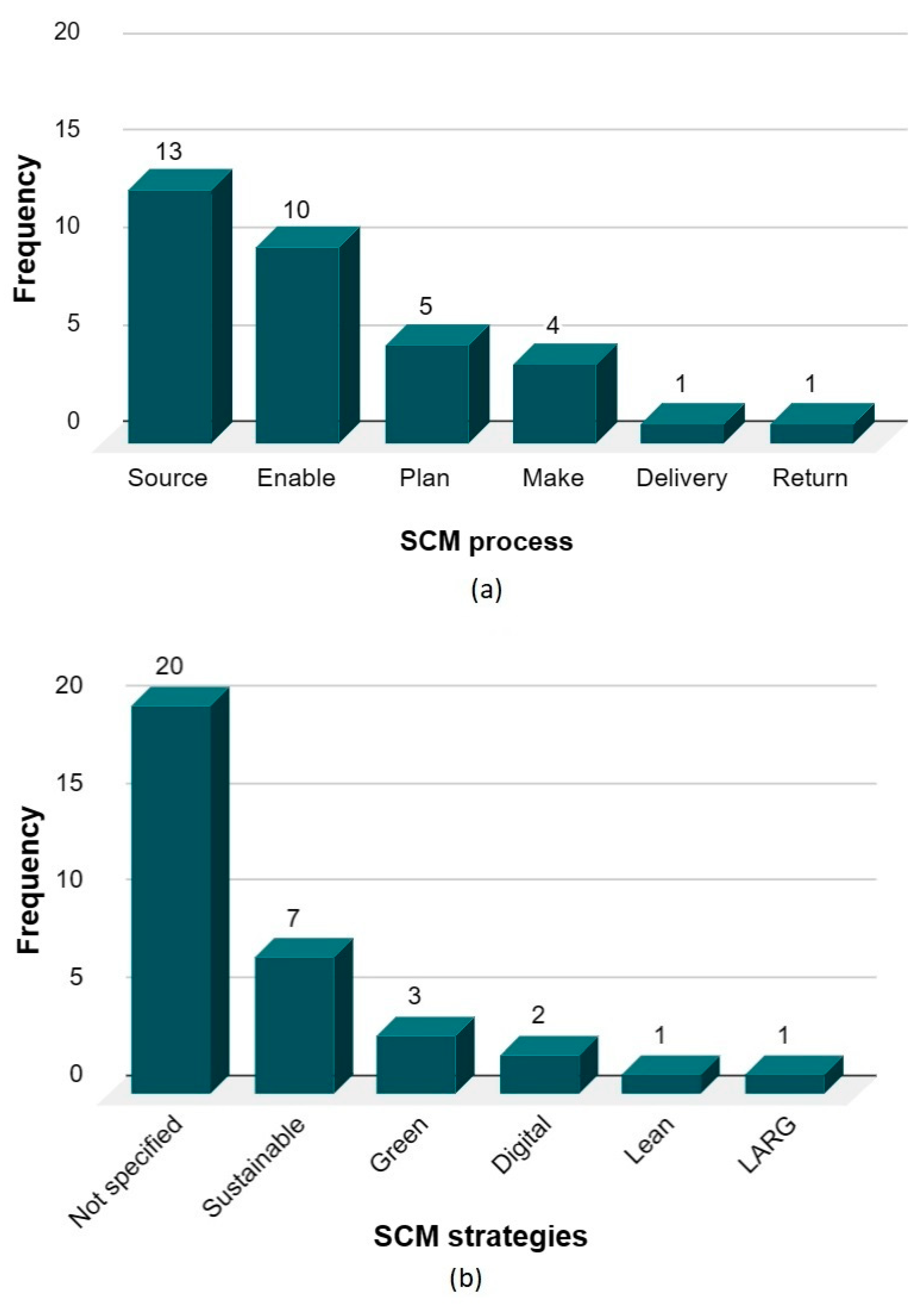
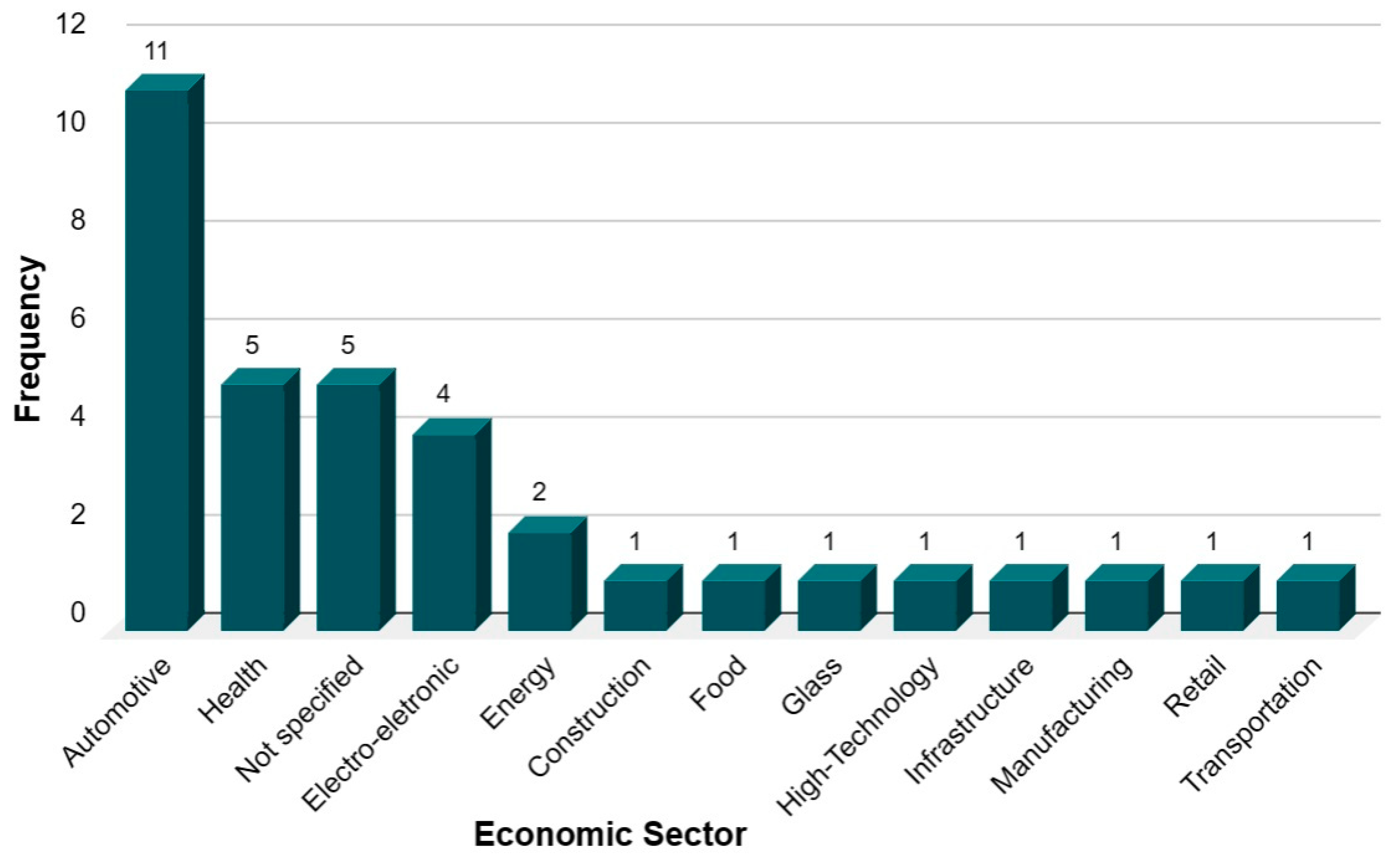
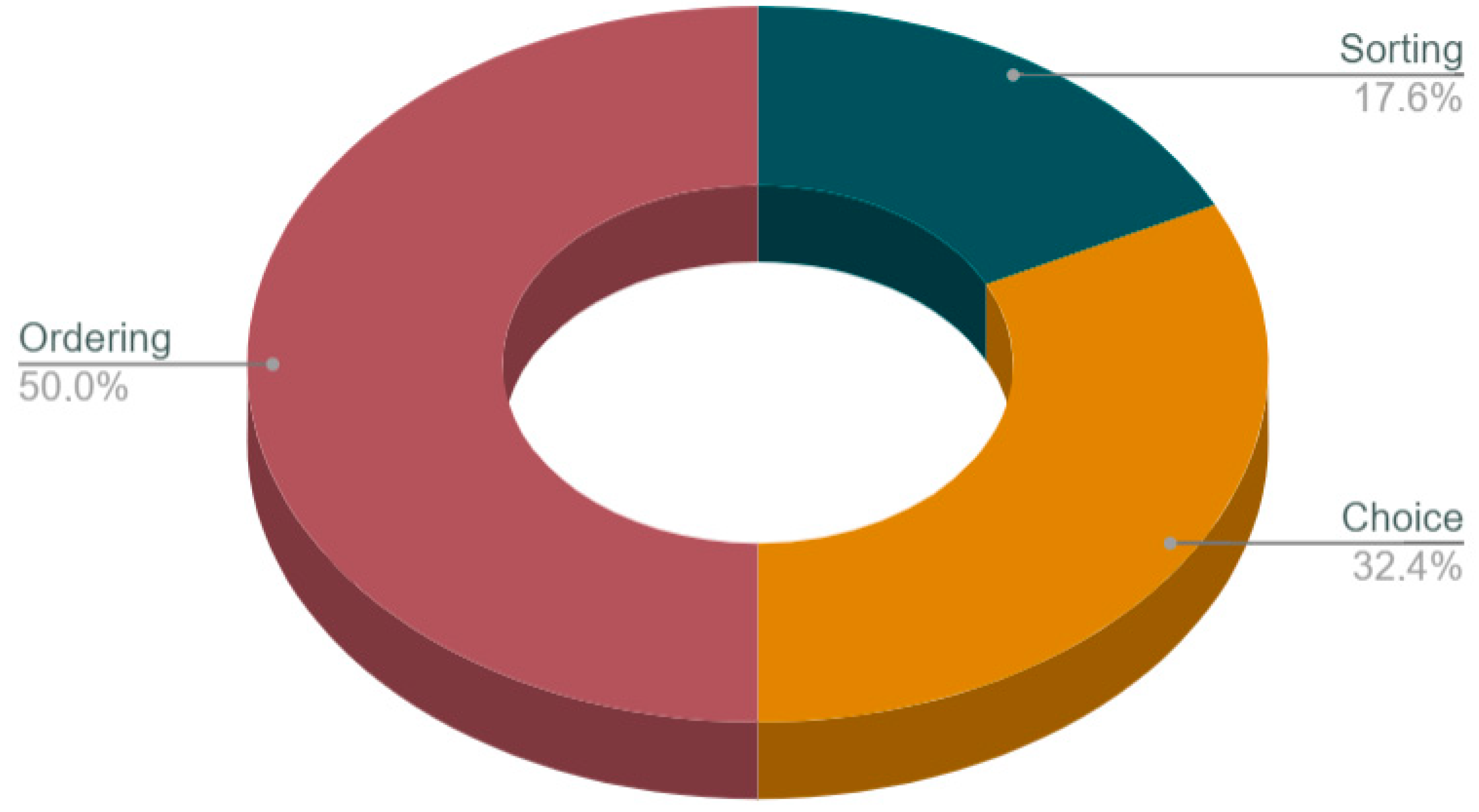
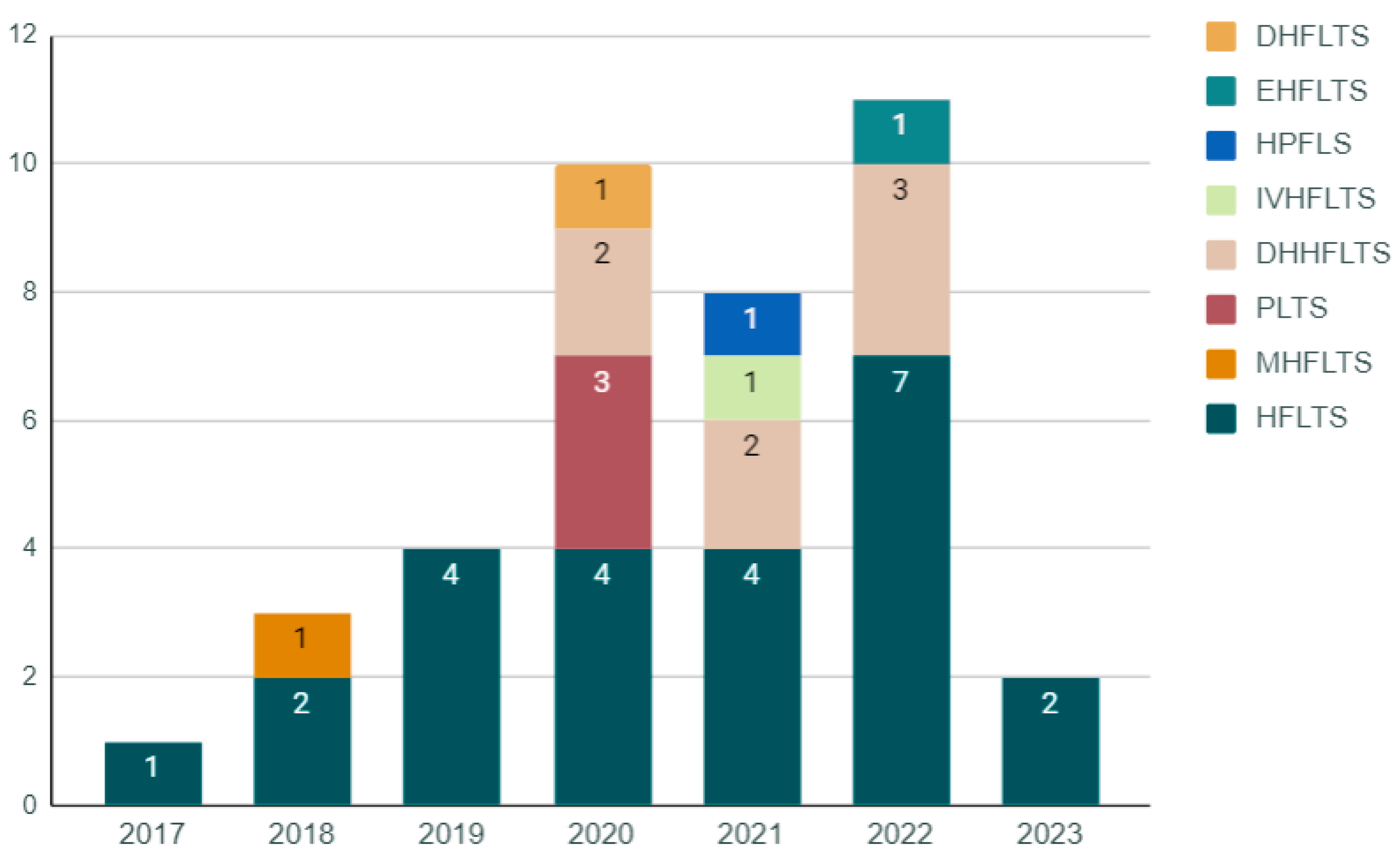
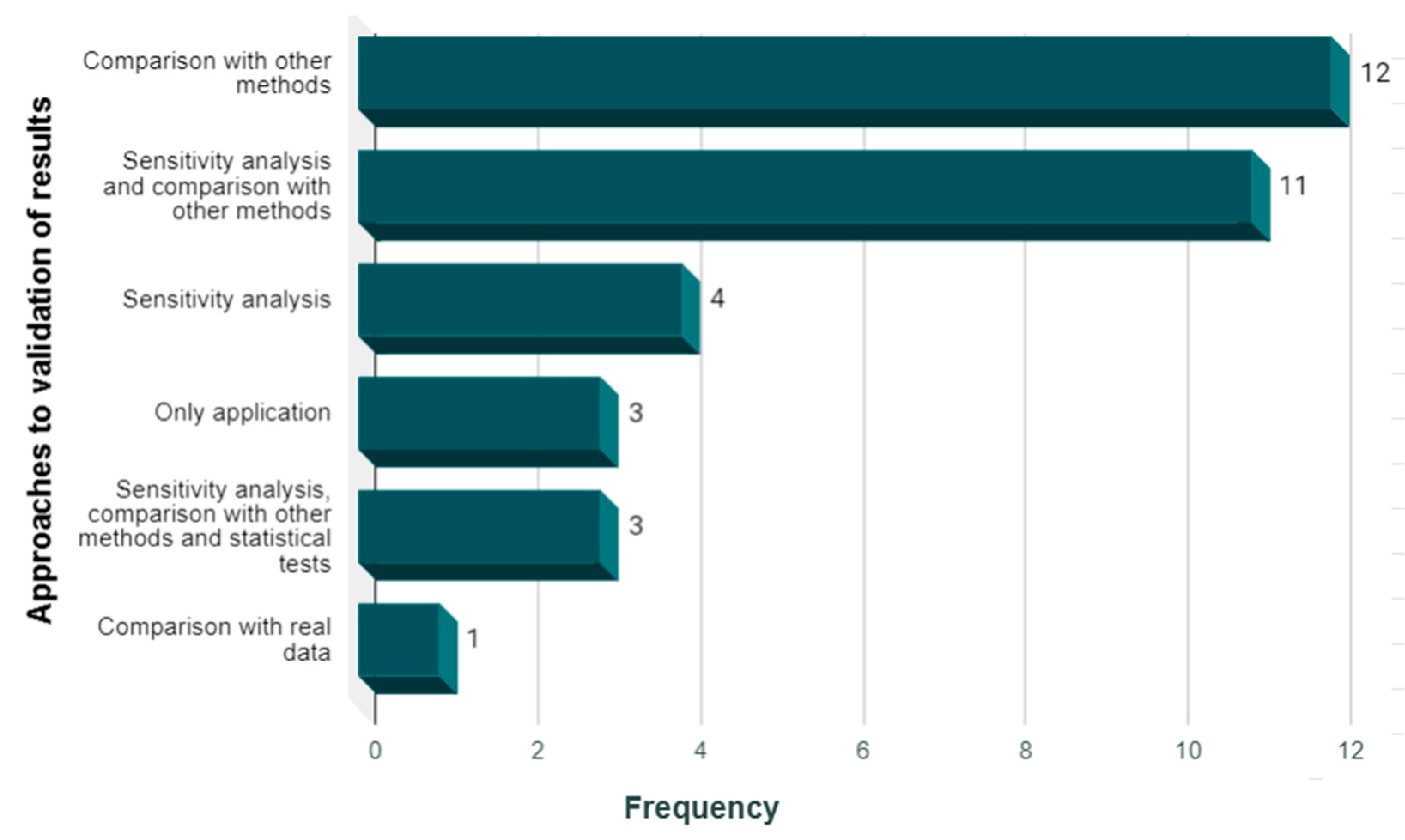
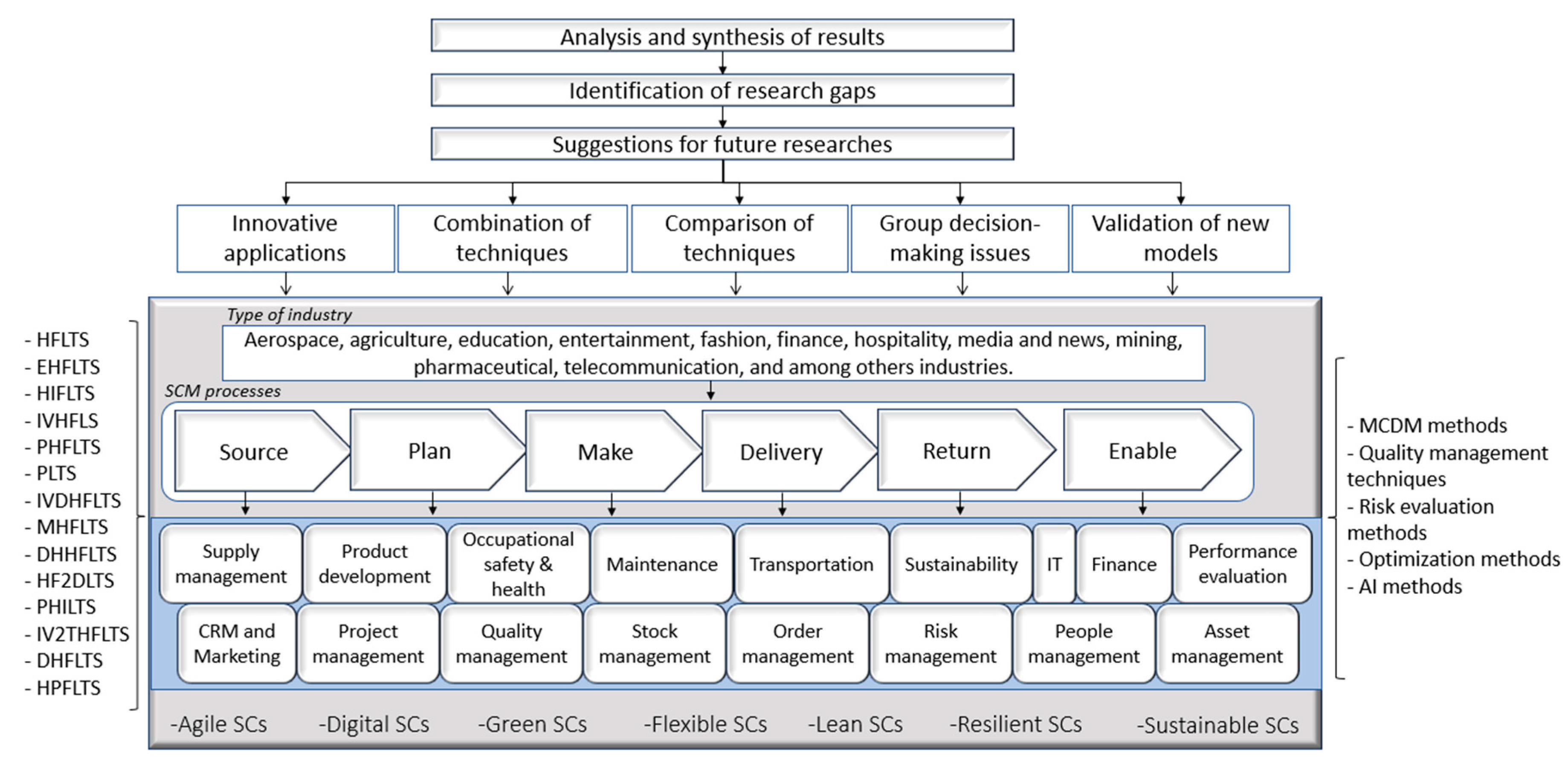
| Liao et al. [22] | Morente-Molinera et al. [23] | Wang et al. [11] | Wang et al. [12] | Yu et al. [24] | |
|---|---|---|---|---|---|
| Focus | Survey of decision-making theory and HFLTS methodologies | Review of approaches to multi-granular fuzzy linguistic modeling | Review of HFLTS developments and their classification according to computational strategies | Mapping of complex modeling techniques which employ linguistic expressions | Bibliometric analysis of 1,080 articles about HFSs and their extensions |
| Approaches analyzed | HFLTSs, fusion theory, Hesitant Fuzzy Linguistic preference relationship theory, among others. | Fuzzy membership functions, HFLTSs, 2-tuples, discrete fuzzy numbers, among others. | HFLTSs, EHFLTSs, linguistic HFSs, and 2-dimensional linguistic terms, among others. | Aggregation operators, information measures, preference relationships, and HFS extensions | |
| Analysis of applications | No | No | Identifies 20 applications in various areas | No | No |
| Comparison between approaches | Yes | Yes | Yes | Yes | No |
| ID | Approaches | Author(s) | Mathematical representation | Example |
|---|---|---|---|---|
| 1 | EHFLTS | Wang [15] | (1) | |
| 2 | HIFLTS | Beg and Rashid [18] | (2) | |
| 3 | IVHFLS | Wang et al. [36] | (3) | |
| 4 | PHFLTS | Chen et al. [16] | (4) | |
| 5 | PLTS | Pang et al. [37] | (5) | |
| 6 | IVDHFLTS | Qi et al. [38] | (6) | |
| 7 | MHFLTS | Wang et al. [39] | (7) | |
| 8 | DHHFLTS | Gou et al. [40] |
(8) |
{} |
| 9 | HF2DLTS | Liu et al. [41] | (9) | |
| 10 | PHILTS | Malik et al. [27] | (10) | |
| 11 | IV2THFLTS | Si et al. [17] | (11) | |
| 12 | DHFLTS | Zhang et al. [42] | (12) | |
| 13 | HPFLTS | Yang et al. [43] | (13) |
| Steps | Research elements | Description | |
|---|---|---|---|
| Planning | Population | Studies which present decision-making problems in SCM. | |
| Intervention | HFLTS and HFLTS extension techniques. | ||
| Comparison | Factors related to the origin of these studies, SCM, HFLTSs and decision making. | ||
| Outcome | - Mapping of the use of HFLTS-based techniques in SCM problems. - Identification of research trends and gaps. - Proposal of directions for future studies. |
||
| Research questions |
RQ1.1. What has been the trend in terms of the number of publications since 2012? RQ1.2. Which countries stand out in terms of the production of articles on this subject? RQ1.3. Which journals have published more studies about this subject? RQ1.4. Which are the most cited studies? RQ2.1. What has been the focus of HFLTS techniques in SCM related problems? RQ2.2. Which SCM processes have received the most attention among the analyzed studies? RQ2.3. With what frequency are these studies devoted to specific types of SCM strategies? RQ2.4. Which economic sectors have received the greatest attention among the identified applications? RQ3.1. Which types of decision-making problems have been addressed by the analyzed studies? RQ3.2. Which HFLTS extension are most frequently used? RQ3.3. How often are techniques integrated in the same problem? What is the frequency of the use of each identified technique? RQ3.4. How are the criteria weights defined? RQ3.5. With what frequency do applications support group decision making? RQ3.6. The weighting of the DMs is considered in which applications? How are these weights defined? RQ3.7. In terms of applications that deal with group decision making, do they use methods to obtain a consensus among the DMs and/or do they perform aggregation operations? RQ3.8. How were the application results validated? |
||
| Keywords | - Hesitant Fuzzy Linguistic Terms Set | Synonyms: HFL, and Hesitant Fuzzy Linguistic. | |
| - Supply Chain Management | Synonyms: supply chain, customer relationship management, customer service management, demand, distribution, location selection, logistics provider, manufacturing flow, order fulfilment, partner selection, procurement, product development, risk, stock, supplier development, supplier evaluation, supplier selection, and transport. | ||
| Databases | - ACM Digital Library, EBSCO, El Compendex, Emerald Insight, the Google Scholar tool, IEEE Digital, Science Direct, Scopus, Springer, Taylor & Francis, Web of Science, and the Wiley Online Library. | ||
| Time frame | 2012-2023 | ||
| Language | - English | ||
| Inclusion criteria | - Studies in English which feature real HFLTS and/or HFLTS extension applications in SCM problems, approved or published in a peer-reviewed journal. | ||
| Exclusion criteria | - Studies which realize simulated applications of HFLTSs and/or HFLTS extensions in SCM problems; - Studies about SCM decision-making that do not apply HFLTSs or HFLTS extensions; - Studies which apply HFLTSs in problems outside of SCM; - Systematic literature review studies; or - Gray literature. |
||
| Conducting | Search string | ("Hesitant fuzzy linguistic" OR "HFL") AND ("supply chain" OR "customer relationship management" OR "customer service management" OR "demand " OR "logistic provider" OR “manufacturing flow” OR "stock " OR "supplier development" OR "supplier evaluation" OR "supplier selection" OR "location selection" OR "order fulfilment" OR “risk” OR "partner selection" OR "distribution" OR "procurement" OR "product development" OR "transport") | |
| Filters | Exhibits only journal published articles in its results; and Exhibits articles published in 2012 or later. |
||
| Study selection | - Realized by the two authors in an independent manner through reading titles, keywords and abstracts. | ||
| Quality assessment | - Realized by the two authors through a complete reading of the article to confirm whether the study performed a real application, was in English, and was peer-reviewed. | ||
| Data extraction | - Performed by the two authors with the help of the Parsifal software, through a complete reading of the articles. The factors considered in the data extraction are presented in Table 4. The data generated in this step was exported into MS Excel. | ||
| Reporting | Classification of the studies | - The classification was performed in accordance with the factors and categories displayed in Table 4. | |
| Summary of the information | - Creation of graphs using MS Excel; - Analysis and summary of the results; and - Identification of research gaps and proposed recommendations for future studies. |
||
| Factors | Categories | References | |
|---|---|---|---|
| Information about the origin of the studies | Year of publication: classifies the selected studies by year of publication and analyzes trends over the years. | - Frequency of publications per year. | Lima-Junior and Carpinetti [6] Resende et al. [7], and Zimmer et al. [46] |
| Country: classifies the selected studies according to the country of the first author’s affiliated institution. | - Frequency of publications per journal. | ||
| Journal: classifies the studies according to the journals in which they were published, in order to find the journals that published the most on this subject. | - Frequency of publications by country, defined based on the affiliation of the authors of each study. | ||
| Number of citations: identifies the most cited articles based on information from Google Scholar. | - Total citations of each study in Google Scholar. | ||
| Factors related to SCM | Application objective: classifies the selected studies based on the main objective of the decision-making problem in question. | - Failure evaluation, risk evaluation, performance evaluation, supplier selection, logistics service provider selection, among others. | Riahi et al. [13], Zimmer et al. [46], Lima-Junior and Carpinetti [6] |
| SCM Processes: based on the application objective, the studies were classified into one of the six main SCM processes. | - Source, plan, make, delivery, return, and enable. | SCC [48], and Riahi et al. [13] | |
| Type of SCM Strategy: groups the studies according to the SCM Strategy adopted by the participating company in the application. | - Agile, digital, flexible, green, lean, resilient, or sustainable. | Lima-Junior and Carpinetti [6], and Resende et al. [7] | |
| Sector | - Automotive, electro-electronics, energy, construction, food, and health, among others. | Riahi et al. [13] | |
| Factors related to decision making and HFLTS | Type of problem: classifies the studies based on the type(s) of decision-making problems in question. | - Choice, ordering, or categorization. | Zimmer et al. [46] |
| Type of HFLTS approach: identifies the frequency of applications of HFLTSs and HFLTS extensions over the years. | - HFLTS, EHFLTS, HIFLTS, IVHFLS, PHFLTS, PLTS, IVDHFLTS, MHFLTS, DHHFLTS, HF2DLTS, PHILTS, IV2THFLTS, DHFLTS, and HPFLTS. | Wang et al. [12] | |
| Combination of techniques: identifies the frequency with which HFLTSs and HFLTS extensions have been integrated with other techniques. | - Frequency of isolated applications and combined applications. | Lambert and Enz [1], Lima-Junior. and Carpinetti [6], and Riahi et al. [13] | |
| Frequency of use of each technique: identifies the frequency of use of each the techniques that have been integrated with HFLTSs or HFLTS extensions. | - Frequency of the applications for each technique | ||
| Criteria weights: identifies whether the selected studies provide support for criteria weights. When they do, it maps how the criteria weights were defined. | - Enable the use or non-use of weights for criteria; - Weights attributed directly by the DMs, or calculated weights; - Method(s) adopted for the weight calculations. |
Kabak [47] | |
| Group decision making: investigates whether the selected studies support group decision-making processes. | - Focused on individual or GDM; - Number of DMs who participated in the application. |
Kabak [47] | |
| Weights for DMs: analyzes whether the selected studies consider weights for the DMs. When they do, it analyzes how these weights have been defined. | - Considers or ignores the weights for the DMs; - Weights attributed by DMs or calculated by some method. |
Kabak [47] | |
| Consensus among DMs: identifies whether the selected studies perform aggregation operations and whether they use methods to obtain a consensus among the DMs. | - Frequency of the use of aggregation methods for the DMs’ preferences and the techniques used to obtain consensus in GDM. | Kabak [47] | |
| Validation: classifies the approaches used for validation of the results for each selected study. | - Based on sensitivity analysis, the application of statistical techniques, and comparisons with other methods or real data. | Lima-Junior and Carpinetti [6] |
| Journal | 2017 | 2018 | 2019 | 2020 | 2021 | 2022 | 2023 | Total |
|---|---|---|---|---|---|---|---|---|
| IEEE Transactions on Engineering Management | 3 | 3 | ||||||
| Applied Soft Computing | 1 | 1 | 2 | |||||
| Computers and Industrial Engineering | 2 | 2 | ||||||
| Environmental Science and Pollution Research | 1 | 1 | 2 | |||||
| Journal of Intelligent & Fuzzy Systems | 1 | 1 | 2 | |||||
| Symmetry | 1 | 1 | 2 | |||||
| Applied Sciences | 1 | 1 | ||||||
| Aslib Journal of Information Management | 1 | 1 | ||||||
| Complex & Intelligent Systems | 1 | 1 | ||||||
| Complexity | 1 | 1 | ||||||
| DYNA | 1 | 1 | ||||||
| Energy | 1 | 1 | ||||||
| Fuzzy Optimization and Decision Making | 1 | 1 | ||||||
| Int. J. of Computational Intelligence Systems | 1 | 1 | ||||||
| Int. J. of Environmental Research and Public Health | 1 | 1 | ||||||
| Int. J. of Information Technology & Decision Making | 1 | 1 | ||||||
| Int. J. of Production Economics | 1 | 1 | ||||||
| Int. J. of Strategic Property Management | 1 | 1 | ||||||
| Int. Transactions in Operational Research | 1 | 1 | ||||||
| J. of Cleaner Production | 1 | 1 | ||||||
| J. of Contemporary Administration | 1 | 1 | ||||||
| J. of Mathematics | 1 | 1 | ||||||
| J. of the Operational Research Society | 1 | 1 | ||||||
| Knowledge-Based Systems | 1 | 1 | ||||||
| Kybernetes | 1 | 1 | ||||||
| Neural Computing & Applications | 1 | 1 | ||||||
| Technological and Economic Development of Economy | 1 | 1 |
| Rank | Author(s) | Number of citations |
|---|---|---|
| 1st | Osiro et al. [19] | 86 |
| 2nd | Wang et al [72] | 84 |
| 3rd | Yalçın and Pehlivan [61] | 72 |
| 4th | Tüysüz and Şimşek [54] | 71 |
| 5th | Liu et al. [51] | 67 |
| 6th | Wu et al. [58] | 56 |
| 7th | Wang et al. [68] | 56 |
| 8th | Liao et al. [49] | 41 |
| 9th | Duan et al. [67] | 32 |
| 10th | Erol et al. [53] | 28 |
| 10th | Chang et al. [59] | 28 |
| Application objective | Author(s) | SCM process | Total |
|---|---|---|---|
| Supplier selection | Liao et al. [49]; Zhang et al. [71]; Krishankumar et al. [77]; Krishankumar et al. [78]; Liu et al. [49]; Dolatabad et al. [50]; Qu et al. [74]; Krishankumar et al. [64]. | Source | 8 |
| Failure evaluation | Chang et al. [59]; Zolfaghari and Mousavi [79]; Dai et al. [66]; Duan et al. [67]. | Make | 4 |
| Performance evaluation | Tüysüz and Şimşek [54]; Büyüközkan and Güler [56]; Divsalar et al. [73]. | Enable | 3 |
| Risk evaluation | Wu et al. [58]; Shen and Liu [65]. | Enable | 2 |
| Logistics service provider selection | Wang et al. [72]; Zhang et al. [70]. | Source | 2 |
| Personnel selection | Wu et al. [75]; Yalçın et al. [61]. | Enable | 2 |
| Location selection | Wu et al. [80]; Ren et al. [81]. | Enable | 2 |
| Barrier assessment | Erol et al. [53]. | Plan | 1 |
| Traffic congestion assessment | Wang et al. [68]. | Delivery | 1 |
| Critical success factor evaluation | Zheng et al. [57]. | Plan | 1 |
| Lean tools evaluation | Pérez-Domínguez et al. [55]. | Plan | 1 |
| Supplier evaluation | Lima-Junior and Hsiao [52]. | Source | 1 |
| Supplier segmentation | Borges et al. [4] | Source | 1 |
| Emergency logistics plan selection | Qin et al. [9]. | Plan | 1 |
| Packaging design selection | Lima et al. [82]. | Plan | 1 |
| Recycling partner selection | Li et al. [69]. | Return | 1 |
| Supplier development program selection | Finger and Lima-Junior [8]. | Source | 1 |
| SC performance indicator selection | Osiro et al. [19]. | Enable | 1 |
| Author(s) | Supports GDM? | Number of DMs | Allows weighting of DM opinions? | How were DM weights assigned? | Method used to calculate DM weights | Aggregates DM opinions? | Procedure used to aggregate DM opinions | Applies iterative consensus method? |
|---|---|---|---|---|---|---|---|---|
| Tüysüz and Şimşek [54] | Yes | 3 | No | N/A | N/A | Yes | HFLTS-AHP | No |
| Osiro et al. [19] | Yes | 3 | Yes | N/A | N/A | Yes | HFLTS-QFD | No |
| Wang et al. [11] | Yes | 3 | No | N/A | N/A | Yes | HM | No |
| Chang et al. [59] | Yes | 4 | No | N/A | N/A | Yes | OWGA | No |
| Wu et al. [58] | Yes | 30 | No | N/A | N/A | Yes | Fuzzy arithmetic mean | No |
| Liao et al. [49] | Yes | 4 | Yes | Attributed numeric values | N/A | Yes | IWGA | No |
| Pérez-Domínguez et al. [55] | Yes | 6 | No | N/A | N/A | Yes | HFLTS-TOPSIS | No |
| Yalçın et al. [61] | Yes | 5 | No | N/A | N/A | Yes | Ordered Weighted Average (OWA) | No |
| Krishankumar et al. [77] | Yes | 3 | No | N/A | N/A | Yes | GMSM | No |
| Li et al. [69] | Yes | 5 | No | N/A | N/A | Yes | GWOWA | No |
| Qu et al. [74] | Yes | 3 | No | N/A | N/A | Yes | Degree of group satisfaction and the regret theory | No |
| Wang et al. [68]. | Yes | Not informed | No | N/A | N/A | Yes | DHHFLTS-ORESTE | No |
| Ren et al. [81] | Yes | 4 | No | N/A | N/A | Yes | Programming model | No |
| Zhang et al. [70] | Yes | Not informed | No | N/A | N/A | Yes | Ratio index-based probabilistic linguistic | No |
| Zhang et al. [71] | Yes | 5 | No | N/A | N/A | Yes | HFLTS-BWM | No |
| Krishankumar et al. [78] | Yes | 3 | Yes | Calculated | Mathematical model | Yes | GMSM | No |
| Liu et al. [51] | Yes | 4 | Yes | Attributes numeric values | N/A | Yes | Based on degrees of hesitancy and similarity | Yes |
| Büyüközkan and Güler [56] | Yes | 3 | No | N/A | N/A | Yes | AHP and OWA | No |
| Lima-Junior and Hsiao [52] | Yes | 2 | No | N/A | N/A | Yes | HFLTS-TOPSIS | No |
| Zolfaghari and Mousavi [79] | Yes | 3 | No | N/A | N/A | Yes | Interval-valued Hesitant Fuzzy Linguistic Prioritized Weighted Average | No |
| Shen and Liu [65] | Yes | Not informed | No | N/A | N/A | Yes | DHHFLTS-COPRAS | No |
| Wu et al. [75] | Yes | 10 | No | N/A | N/A | No | N/A | Yes |
| Finger and Lima-Junior [8] | Yes | 1 | No | N/A | N/A | Yes | HFLTS-QFD | No |
| Erol et al. [53] | Yes | 19 | No | N/A | N/A | Yes | HFLTS-Delphi and HFLTS-ANP | Yes |
| Qin et al. [9] | Yes | Not informed | No | N/A | N/A | No | N/A | No |
| Divsalar et al. [73] | Yes | 12 | No | N/A | N/A | No | N/A | Yes |
| Borges et al. [4] | Yes | 2 | No | N/A | N/A | Yes | HFLTS-TOPSIS | No |
| Duan et al. [67] | Yes | 5 | Yes | Calculated | Nonlinear programming and genetic algorithm | Yes | Double Hierarchy Hesitant Linguistic Weighted Average (DHHLWA) | No |
| Dai et al. [66] | Yes | 3 | Yes | Calculated | Entropy weight method | Yes | Entropy weight method | No |
| Wu et al. [80] | Yes | 3 | Yes | Calculated | Optimization model | Yes | Optimization model | No |
| Lima et al. [82] | Yes | 4 | No | N/A | N/A | Yes | HFLTS-AHP and OWA | No |
| Krishankumar et al. [64] | Yes | 3 | Yes | Calculated | WDA algorithm | Yes | Attitudinal-CRITIC approach | No |
| Dolatabad et al. [50] | Yes | 11 | Yes | Calculated | Method not defined | Yes | Hesitant Fuzzy Linguistic Weighted Average (HFLWA) | No |
| Zheng et al. [57] | Yes | 22 | Yes | Calculated | Maximizing consensus approach | Yes | HFLTS-DEMATEL | No |
Disclaimer/Publisher’s Note: The statements, opinions and data contained in all publications are solely those of the individual author(s) and contributor(s) and not of MDPI and/or the editor(s). MDPI and/or the editor(s) disclaim responsibility for any injury to people or property resulting from any ideas, methods, instructions or products referred to in the content. |
© 2023 by the authors. Licensee MDPI, Basel, Switzerland. This article is an open access article distributed under the terms and conditions of the Creative Commons Attribution (CC BY) license (http://creativecommons.org/licenses/by/4.0/).





